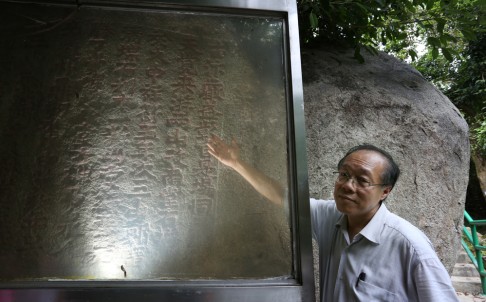Chinese historian Ho Koon-wan explains the inscription dating back to the Song Dynasty. The declared monument in Sai Kung is the oldest dated inscription known in Hong Kong. Photo: Nora Tam
While the archaeological finds along the new Sha Tin-Central link have caused a stir, a rock that may shed light on the discoveries stands largely unnoticed in a quiet corner of Sai Kung.
It bears a 740-year-old inscription that documents salt production in Hong Kong back in the Southern Song dynasty (AD1127 to AD1279). It is the oldest-dated inscription known in Hong Kong.
The rock, on a slope above the 748-year-old Tin Hau Temple at Joss House Bay, is a declared monument under legal protection. The text – still mostly legible – states that the inscription was carved on July 20, 1274, upon the request of resident Lin Daoyi.
It documents a visit to two nearby temples by the official in charge of the local salt administration, Yan Yizhang, of today’s Kaifeng city in Henan province, and a friend.
The rock’s testimony to the existence of a salt production administration may shed light on the Song Dynasty remnants found on the site of the new To Kwa Wan station in Kowloon City, according to Polytechnic University historian Dr Ho Koon-wan, a Song dynasty specialist.
“I would prudently say that the remnants unearthed in Kowloon City might have been the site of the office of Kwun Fu Cheung, the official salt production unit in the Song dynasty … The wells and nullah do not look like part of residences of common people,” he said.
The existence of a Kwun Fu Cheung is seen in various secondary historic records, but its exact boundary is unknown.
“It was an administrative unit and could have covered a large area, say today’s Hong Kong Island, Kowloon and the New Territories. But there must have been an office and it could have been at the Kowloon City site based on what has been found.”
Another historian, Dr Chiu Yu-lok, of the Open University and editor of Kowloon City, a collection of articles on the district’s history, has already found similarities between the MTR dig and pictures showing ancient salt production methods in Exploitation of the Works of Nature, a 17th-century Chinese science and technology encyclopedia.
The Sai Kung rock, unfortunately, demonstrates the city’s conflicting approaches to conservation. A transparent board has been installed some 20cm in front of the rock. Ho said the board afforded the inscription little protection from weather erosion and vandalism.
But Antiquities Advisory Board member Tim Ko Tim-keung said the board had discussed the protection of historic inscriptions in the city about and found no perfect solutions. “Some experts told us that if we totally enclosed the surface of the rock, moss would be quick to grow and further weather it.”
Watch: Oldest dated inscription from the Song dynasty sheds light on Hong Kong's history

No comments:
Post a Comment